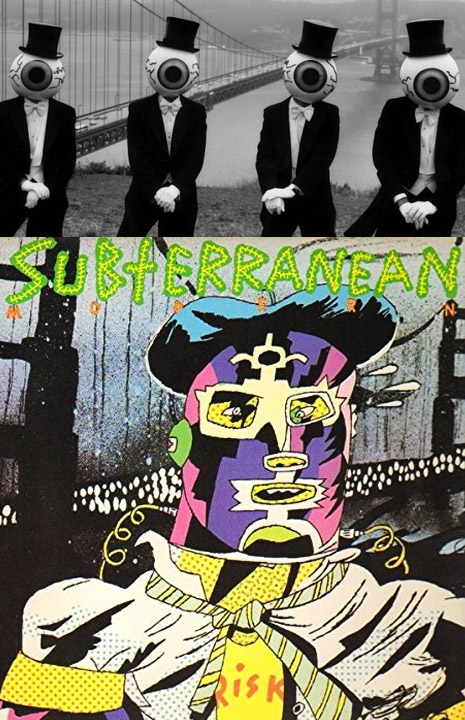_465_706_int.jpg)
Since much of Renaldo & The Loaf’s work experiments with time, it makes a funny kind of sense that, on 2017’s Gurdy Hurding, the duo picked up right about where they left off with 1987’s The Elbow Is Taboo. Perhaps, like all the tapes they’ve run backwards over the years, their music really does borrow from the future. In the early days especially, they liked to play songs unsinging themselves, the sound of speech sucking itself back up through the lungs to its point of origin in the brain. And wouldn’t it be wonderful, inhaling song and speech out of the environment into your nervous system?
You would be unlikely to mistake Renaldo & The Loaf’s music for someone else’s. The sound, an emergent property of Renaldo Malpractice and Ted the Loaf’s decades-long musical friendship, is entirely homemade, but ingeniously fitted together and sturdily constructed—each song a miniature feat of engineering, built to last. “Primitive modernism,” Ralph Records called it in 1981, announcing the release of Songs for Swinging Larvae.
So while the timbres and harmonies can be bracingly unfamiliar, Renaldo & The Loaf’s songs teem with earworms, and probably brain- and spineworms, too. In fact, let me take this opportunity to recommend that the songs themselves be classified and studied as new zoological discoveries. (These days, when I listen to Klanggalerie‘s pristine and greatly enlarged editions of the Renaldo & The Loaf catalog, I often picture the menagerie of intergalactic pilgrims in Clark Ashton Smith’s “The City of the Singing Flame.”)
Alex Wroten’s excellent new documentary 23rd Century Giants, out March 8 on Blu-ray and streaming platforms, tells how two teenage Tyrannosaurus Rex fans from Portsmouth became the weirdest band on Ralph. Along with Renaldo Malpractice and Ted the Loaf themselves, the documentary collects testimony from the Cryptic Corporation’s Homer Flynn, Jay Clem, and the late Hardy Fox; the visionary director behind Renaldo & The Loaf’s Songs for Swinging Larvae video, Graeme Whifler; veterans of the Ralph and T.E.C. Tones labels, and patient recipients of my adolescent correspondence, Tom Timony and Sheenah Spece; album illustrators Poxodd and Steven Cerio; and DEVO archivist Michael Pilmer, among others.
Some highlights follow from my recent conversation with director Alex Wroten and the two learned rotcods.

Renaldo & The Loaf, 1982 (courtesy of Well Dang! Productions)
Is this the first time the two of you have been in front of the camera very much, Brian and David? The “Backwards Film Study” that’s in there seems to come from the early Eighties—
Brian Poole (Renaldo Malpractice): Oh, you’ve seen that, have you? [Laughs]
Well, I’ve just seen the little bit that’s in the documentary. I’m looking forward to seeing the full thing on the Blu-ray.
David Janssen (Ted the Loaf): That’s it. It’s only very short, that’s all there is.
Brian: Basically, yeah. Three minutes, that’s it!
David: And no, we’re not really used to being in front of the camera much. There’s that three-minute thing; there’s, I suppose, the filming we did for the “A Convivial Ode” video…
Brian: And that’s it, really, isn’t it?
David: I mean, unintentionally, the stuff that was filmed live. I mean, that was just, someone happened to film it, so we weren’t really conscious of being in front of a camera.
This is the Vienna show you’re talking about?
David: Yeah, yeah, yeah. So I suppose Alex’s documentary is kind of the longest we’ve ever been under the lights of movie cameras.
Brian: Yeah, that’s right. But of course, we didn’t have to do makeup or anything like that, or costumes. [Laughs]
Alex Wroten (director, 23rd Century Giants): Well, not totally true, ‘cause there’s the part where you’re wearing the glasses [designed by Poxodd], so you did a little costumes.
David: And the masks.
Brian: In answer to your question, no. We’re really not used to being the center of attention, if you like. There have been stills done. Up in the Eighties and that, we did sort of go into a studio and have some photos done of us, but apart from that, no. In fact, the material that Alex asked for—I mean, obviously, as the documentary was coming to fruition and that, he wanted to say “What visual material do you have?” And it was a very, very useful thing looking through the archive, which, fortunately, I’ve got it here, our stuff, because I haven’t moved house, and it’s just here. So I was able to find quite a lot of stuff, but, you know, there’s some creative stuff that Alex had to do in the film to illustrate certain things, let’s say.
More after the jump…






